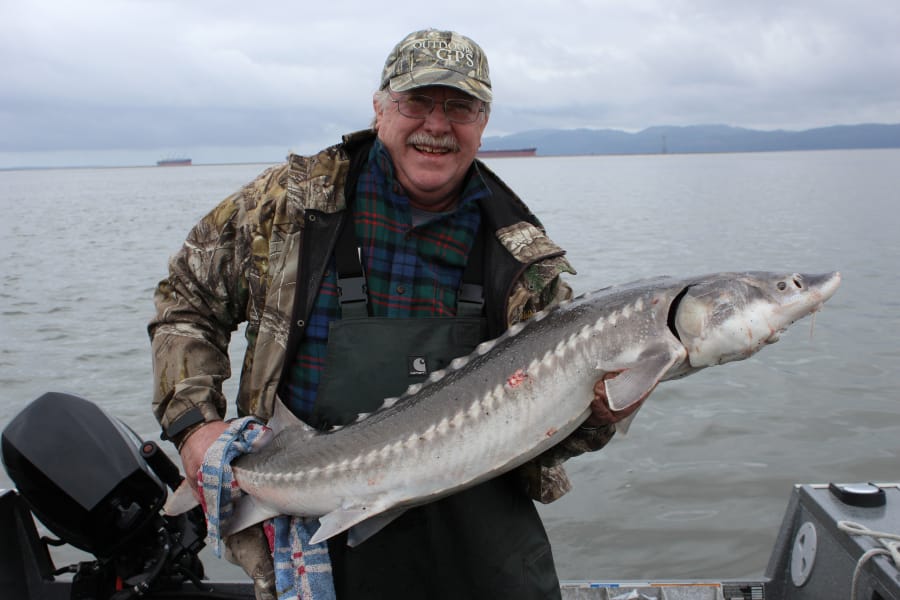It had been a long time since I had fought a large sturgeon, and I had forgotten how powerful they could be. This one had taken to the air right after the hook-up, and then settled into a protracted, line-burning run.
After a while my arm muscles started to ache as I struggled to lift the rod and reel up line against the resistance of the muscular fish. I stuck with it, knowing full well that if I let up on the pressure the barbless hook would pop out, and I would get nothing for my efforts.
Eventually the big sturgeon tired, and I lifted the rod so my host for the day, Oregon fishing guide Bob Rees, could slip the net under the fish and bring him onboard.
The slot for keeping white sturgeon is 44 to 50 inches, measured from the tip of the fish’s nose to the fork in the tail. The prehistoric-looking fish measured 45 inches fork-length, so he went into the fish box.
During the recent sturgeon retention season, which ended Wednesday, anglers have been able to retain keeper-sized sturgeon on Saturdays, Mondays and Wednesdays. With retention now closed, the very worthy catch and release fishery will begin and run into September.
There is a possibility that fisheries managers will allow more retention days, but that will depend on how much of the quota was caught during the fishery. Anglers should keep an eye out for announcements from the states regarding any future retention fisheries.
According to Rees, fisheries managers allow the retention during the spring, which is not nearly as productive as fishing during the summer months.
“If they held the retention openers during the peak fishery, we would burn through the quota in no time,” said Rees. “The catch and release fishing in the Columbia is world-class. We can have 60 and 70 fish days.”
On this particular day I was lucky to land a keep-able fish. We had no shortage of bites, but most were tepid in nature, and we struggled to get good hook-sets on most of them.
Often, we would set the hook solidly only to have the hooks pop out shortly thereafter.
In addition to the keeper sturgeon, we only managed to land two undersized sturgeon for all the bites we got. And, even though Rees likes to fish both anchovies and sand shrimp on different rods, the fish seemed only to be interested in the sand shrimp.
Rees explained that sturgeon pull into the deep channels to feed during the dropping, outgoing tides. However, as the tide starts coming in, the fish move up out of the channels to feed on the shallow flats. That is when he starts fishing shallow, sometimes in just a couple feet of water.
“This time of year, they are feeding on sand shrimp and clams,” said Rees. “As summer arrives and the flows in the Columbia drop, the salinity increases.”
That is when the anchovies move into the estuary in big numbers, and the sturgeon come in after them. They hang around and feed on the bait fish until the colder weather arrives in the fall.
Rees remarked that those summer fish, fresh from the saltwater, are beautiful sturgeon that are packed with energy for line-pealing runs and acrobatic leaps.
He targets them by spreading his baits across as wide an area as he can, to send a broad scent trail through the water. As the fish hone in on the scent and find the bait the action can be nonstop.
But first, you have to find the fish.
“I continue to move until I find the schools,” he said.
To do this, Rees searches for the schools with his electronics, but if he sets the lines and does not get bit in a half hour or so, he picks up and moves on.
He loads his baits — anchovies, and sand shrimp — on Dacron leaders and number 5 barbless hooks. Barbless fishing is required for all sturgeon fishing in the Columbia.
Sturgeon have very sensitive mouths, and if they feel anything out of the ordinary when they pick up a bait, they quickly drop it. It requires a steady hand to pull a rod from its holder when a sturgeon bites. Do it carefully and you have a good chance at hooking the fish.
If you are careless, you end up with nothing.
Sturgeon will play with an anchovy, so anglers must let the fish mouth the bait for a while before setting the hook. However, they will suck a sand shrimp right in, so when you fish them you must set the hook immediately.
Since barbless is the rule, constant pressure must be kept on the line during the fight. Allow any slack in the line, and the fish is gone.
There is so much habitat in the Columbia River estuary that it is just short of impossible to pinpoint any particular areas that produce better than others. The fact is, the sturgeon can be anywhere in this expansive reach of the big river.
However, a couple good areas to start include the channels and flats around Rice and Miller Islands.
With retention over, Rees is looking forward to the catch and release sturgeon season, and the hot action that it brings. He will stick with these fish until August, when the fall salmon season starts in earnest.
If reeling in a bunch of hard-fighting sturgeon this summer sounds like fun, the time to call Rees is right now.
Guided trips: Oregon Fishing Guide Bob Rees: (503) 812-9036,
https://www.northwestguides.com/fishing/




